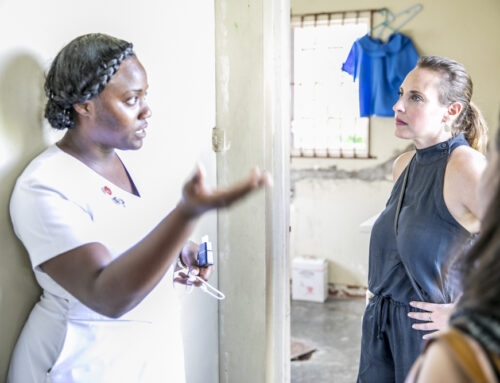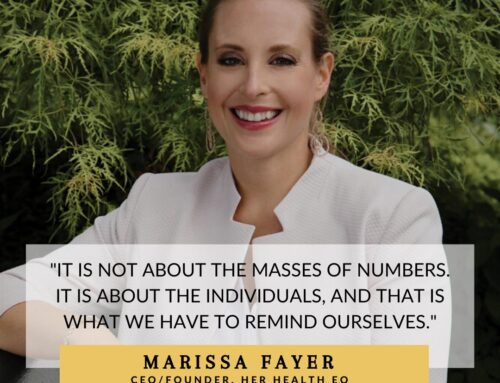I was interviewed at TheStreet.com and featured on their podcast accompanying this great article.
Main message: Everyone can be a philanthropist…. find your passion (for me it’s Health Equity for Women), and find something to do with it. The size of the impact doesn’t matter, as long as you start, are committed, and passionate.
Podcast direct link: https://soundcloud.com/thestreetlive/philantropy-helps-your-companys-bottom-line
Article direct link: https://www.thestreet.com/personal-finance/channeling-your-inner-bill-gates-and-going-the-non-profit-route-14572348

Channeling Your Inner Bill Gates and Going the Non-Profit Route
Starting a non-profit isn’t easy, but the rewards in getting it right are abundant.
Billionaire couple Bill and Melinda Gates have set the gold standard for non-profit work and charitable giving.
The couple’s Bill & Melinda Gates Foundation, focused on critical issues like global health, education, libraries and public access to education, has a total endowment of $23.5 billion, and stands as a beacon of light on how citizens can do well by doing good — one dollar at a time.
The fact is, you don’t have to be a billionaire like Bill Gates to give back in charity.
There are ways everyday individuals, families and organizations can make a difference, and the key is steering those efforts, as the Gates have done, to channeling charity-minded efforts through a non-profit organization.
“I started Heroes to Heroes in 2010 with a $100 donation from a friend,” states Judy Schaffer, director of Heroes to Heroes Foundation, in Fort Lee, N.J. “We’ve since grown to almost $1 million in funding.”
Schaffer cites several key attributes needed to launch a successful non-profit. Having a clear mission, a unique concept and a passion for those the organization serves are at the top of the list.
Yet don’t equate the formulation of a non-profit as being the same as succeeding in the for-profit corporate worlds – the two are similar but not the same. One requires a special set of skills.
“Starting a nonprofit and building it successfully has forced me to use and develop skills that I would have never used in the for-profit world,’ Schaffer says. “The founder of a nonprofit has the same responsibilities of any business owner/CEO but finding, developing and nurturing donors is more difficult than funding customers in the corporate world.
“Launching a non-profit is a huge effort that requires stamina, passion and business acumen.”
Getting Started Launching a Non-Profit
How do you start a non-profit?
The first step is checking to see if your non-profit is a “one of a kind” idea that will stand out amidst other, possibly similar organizations.
That’s the reality when 1.5 million non-profit groups are registered in the U.S., according to the National Center for Charitable Statistics. That figure includes public charities, private foundations, and other types of nonprofit organizations, including chambers of commerce, fraternal organizations and civic leagues, according to the NCCS.
“If you have a great idea for a non-profit, you want to register your nonprofit as a 501c3, create a board of directors and look for grants/donors/family foundations to help with the cost of running a nonprofit,” says Julie Cegelski, program manager at Walk with Sally, a non-profit based cancer support group for families in Los Angeles.
You’ll want to start that process with a mission statement.
“In creating your mission statement, you should know two things. Why you’re creating this organization and who you intend to serve,” says Shaunette Stokes, managing partner at Stokes Law Group, PLLC, in Tampa, Fla.
Next, start the process of choosing a board of directors. “Many states required a minimum of three board of directors to start a non-profit,” Stokes says. “The first step in choosing a board of directors is to choose like-minded individuals. I propose taking a few candidates out to lunch and pick their brains. Be sure to ask them questions pertaining to your mission statement. Your board of directors should believe in your mission.”
Getting Funding for Your Charity
Once you have a mission state and board established, getting proper funding is the primary obstacle in building a non-profit, as TheStreet guests Rashida Jabbar, CEO of Rashida Jabbar Consulting and Marissa Fayer, CEO of Fayer Consulting, LLC discuss in this podcast.
“The best way to attract funding is by being authentic in your messaging, and fully explaining why are you doing what you are doing,” she says. “Identifying the “why” factor and then sharing the story authentically with friends and family will be a great way to light the funding flame at the local level. Ask friends and families to be ambassadors and share with their friends and family and soon enough it will spread.”
Writing grant proposals is a big part of the funding task, and the more work you put into a grant, the better your odds of finding funding.
“Find grant opportunities that focus on your niche market,” Cegalski says. “If your nonprofit supports animals, for example, look for companies and grants that focus on animal charities. Study the groups they have given to in the past and begin creating your own story. Basically, grants want to gauge your non-profit’s potential impact and the ideas for future growth, so creating a one-, two-, three-year plan is a good idea.”
It helps to think creatively when seeking non-profit funds.
“I strongly encourage nonprofits to think about their funding needs, realizing that everything doesn’t have to be cash,” says Froswa Booker-Drew, and author and consultant at Soulstice Consultancy. “Many needs can be resolved by “in kind” donations including supplies, equipment and even human capital. I’ve had companies provide staff to conduct strategic plans or give away office furniture. Colleges have provided interns to conduct studies.”
Nonprofits should also make sure they diversify their funding sources and not solely focus on foundations, but consider entrepreneurial opportunities as well. “They should also pay attention to the generational differences of
their donors,” notes Booker-Drew. “Their needs are different and marketing to them should be as well.”
Tax and Legal Issues
For your own individual legal and financial protection, all non-profits should take the time to procure a 501c3.
“That will give you tax exemptions as a non-profit corporation,” says David Hryck, a tax lawyer and partner at Reed Smith in New York City. “It can be a complicated and timely process but it’s an important one to take.”
“One of the main benefits of having 501c3 status is that if your charity earns profits, you won’t need to pay income tax on it,” says Hryck. “This would apply to any money that is earned via charitable activities.”
Additionally, if your non-profit doesn’t have tax-exempt status, you’ll have a much more difficult time securing public and private grants. “If your organization becomes a tax-exempt nonprofit corporation, donors can deduct their gifts to your group on their federal and state tax income returns,” he adds. “This is a win-win situation for both parties.”
Another benefit that comes with taking the time to become a non-profit corporation is the protection you will gain from personal liability.
“For example, if your non-profit ever faces a lawsuit, you’ll have a high level of personal protection for everyone involved,” says Hryck. “Note, that non-profit corporations can be sued, but anyone associated is almost always protected on a personal level.”
“This means that people associated will not be at risk when it comes to their property and savings,” he adds.
A Serious Undertaking
While you don’t have to have the cash that Bill and Melinda Gates possess to run a non-profit, you’ll need the work ethic, discipline and vision the Gates’ bring to the table.
“Working for the public good is serious business,” says Regina Birdsell, president of The Center for Nonprofit Management, a 40-year-old California-based organization that offers professional development for social impact leaders. “In California, the nonprofit sector employs 4% of the workforce providing medical care, educational enrichment, arts and culture, food, shelter and much more.”
Birdsell says she finds that most people who come to us to start a nonprofit don’t understand that nonprofit organizations face many of the challenges for-profit businesses confront. “That includes managing people, budgeting and banking, IT, fundraising, and strategic planning, all the while serving the public benefit that is typically driving their passion to help others,” she says.
“Often, they want to do things their own way without realizing that nonprofit organizations are governed by a board of directors and the level of transparency required by the IRS, grantmakers and government departments is very high.”
Keep all of the above in mind when you’re trying to get your non-profit off the ground. The process won’t be easy, but it could be so rewarding when your organization starts to make a difference.





